Applying Poly to Old Kitchen Cabinets Thaat Are Spot Stained
How To Refinish Wood Cabinets the Easy Way
Are you thinking about ways to refinish wood cabinets? You probably know that the "correct" way to refinish wood cabinets is to follow these steps: strip, sand, stain, poly. Sounds like (and is!) a lot of work.
So what are your options if you want to refinish wood cabinets, but don't have the time or energy to do all that work?
This is the situation that I was in. I wanted to refinish wood cabinets in my kitchen, but didn't want to live without a kitchen for weeks while I was waiting for the process to be completed. So I started researching ways to refinish wood cabinets that didn't include all that time and effort. There were several options. My first idea was to paint them. I knew that this would removing the doors, sanding everything, priming everything, spraying the doors with paint sprayer, painting the bases with a brush, more sanding, more sanding, spraying and painting, and then putting everything back together. I didn't want to go through all this if I didn't have to. Plus, it was the dead of winter, and I couldn't spray the doors outside for at least 2 more months.
My next option was to figure out how to stain them easily.
I stumbled upon a product called Minwax PolyShades. It claimed that it could go over stained wood furniture that has a polyurethane finish.
To test this, you can take a cotton ball and soak it in acetone nail polish remover. Then, put it on your stained furniture in an inconspicuous place. If the finish gets gummy, or the cotton ball sticks to the wood, then you cannot use PolyShades. But, if nothing happens, you can refinish wood cabinets using PolyShades.
Well, I tried it out, and to my delight, nothing happened! So, I headed out to purchase the color I wanted. We wanted a super dark color, so we settled on Tudor. Minwax also makes an Espresso color but we couldn't find it at either of the two stores we tried.
Here is how we refinished our wood cabinets using PolyShades.
First, my before picture:

The cabinets were that really light oak wood that was popular in the 90's or so. They were actually really pretty cabinets though, with nice decorative moulding on the top, so I knew they had potential.
This post may contain affiliate links. If you have any questions, please see my disclaimer page.
Materials List:
- Spic and Span (or other non-sudsing cleaner)
- Liquid Sander (optional – to remove heavy grease on surfaces)
- 220 grit sandpaper
- Minwax PolyShades
- Natural Bristle Brush (my favorite is this Purdy one)
- 0000 Grade Steel Wool
- Shopvac (or regular vacuum)
Directions:
Our first step was to wash the cabinets. We used Spic and Span because it is a non-sudsing cleanser that doesn't need to be rinsed (if you dilute it with water). After scrubbing it really well, let it dry, and then started to sand it.
Thankfully, Minwax only recommends a light sand before applying the stain. Yes! So we used 220 grit sandpaper and sanded every surface. When we were doing this, we noticed that the ledges on the cabinets above the microwave were gummy from grease. Yuck. So we scrubbed those again REALLY WELL with the Spic and Span. A liquid sandpaper would have also worked, but we didn't have one on hand.
After sanding all of the finished surfaces, we wiped it down again with a wet rag to remove all of the sanding dust. (In retrospect, we should have also vacuumed all of the crevices… live and learn I suppose.)
Time to Stain!
First, let me say, see how quick that prep work was!? This is the sort of DIY I love, because I always want instant gratification on my projects (and with 3 kids 4 and under, I don't have an extra second to waste).
So anyways, on to staining.
I opened the stain and stirred it well with a paint stick. Then I used my Purdy natural bristle brush to apply it. Because it is a stain with a poly built in, it is a little bit thick and sticky. It is really important to keep a "wet edge," which basically means to make sure you're not dragging a dry brush across the surface. This will ensure that the stain goes on evenly. Also though, make sure you do not put this on too thick! You need to put on a very light coat, but make sure you keep a wet edge the whole time. It takes a bit of practice to get the right amount of stain on your brush.
I started by staining the door faces. I did the center part in long, even strokes from the top to the bottom. Then I went back and did them from the bottom to the top. The stain stays wet for a minute or two, but after that it will start to get gummy so make sure you don't over work it. After the door face was done, I ran my brush down and across the decorative edges in a box. Then, I brushed the very outer part of the door frame.
At this point, take a look at what you've already done. Check for places where the stain is starting to drip. If you put it on too this, it will drip, and it may not show up right away. Remember to keep checking back! If you see a drip, run your brush across it.
Once the doors were done, I opened the doors up and did the cabinet boxes in the same way. Always brush in the same direction of the grain, and check back frequently for drips.
Then, I let it dry for 6 hours.
My first coat looked like this:
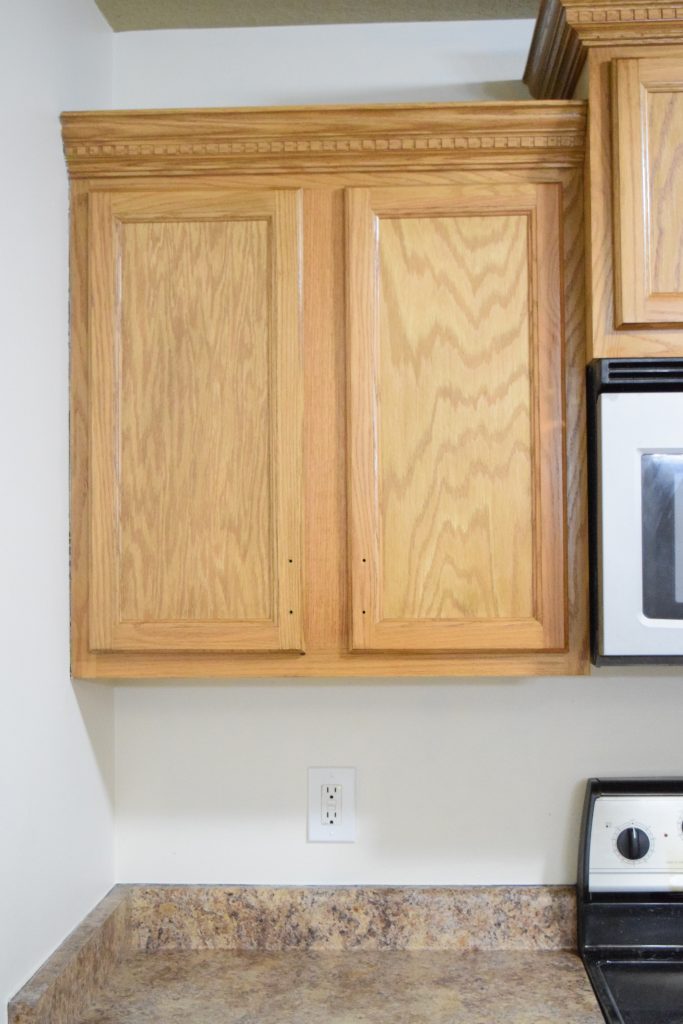
Pretty underwhelming right? Is it even darker? Yes, it is. But just slightly. Now when I purchased Minwax PolyShades, I was expecting one or two coats to get me to the color on the can. I was definitely wrong.
So I gave it a light sand all over with my steel wool, wiped it down again and *should have vacuumed it.
My second coat looked like this:
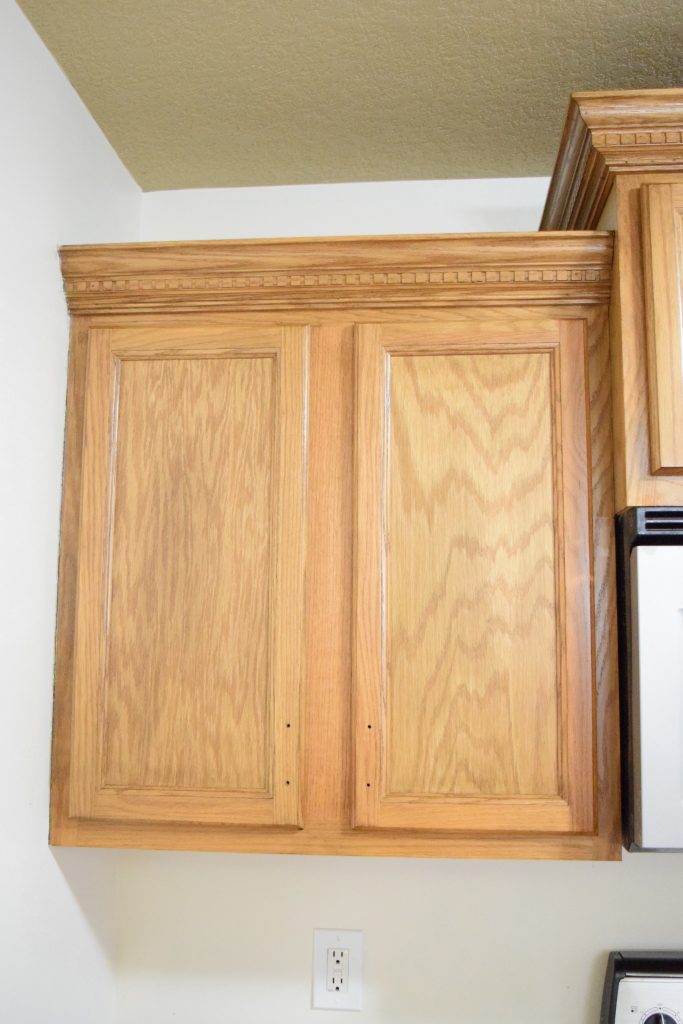
Alright, its getting a little darker again. But nowhere near what I was hoping for. So I let it dry again for 6+ hours and sanded with steel wool, wiped, and applied another coat.
My third coat looked like this:
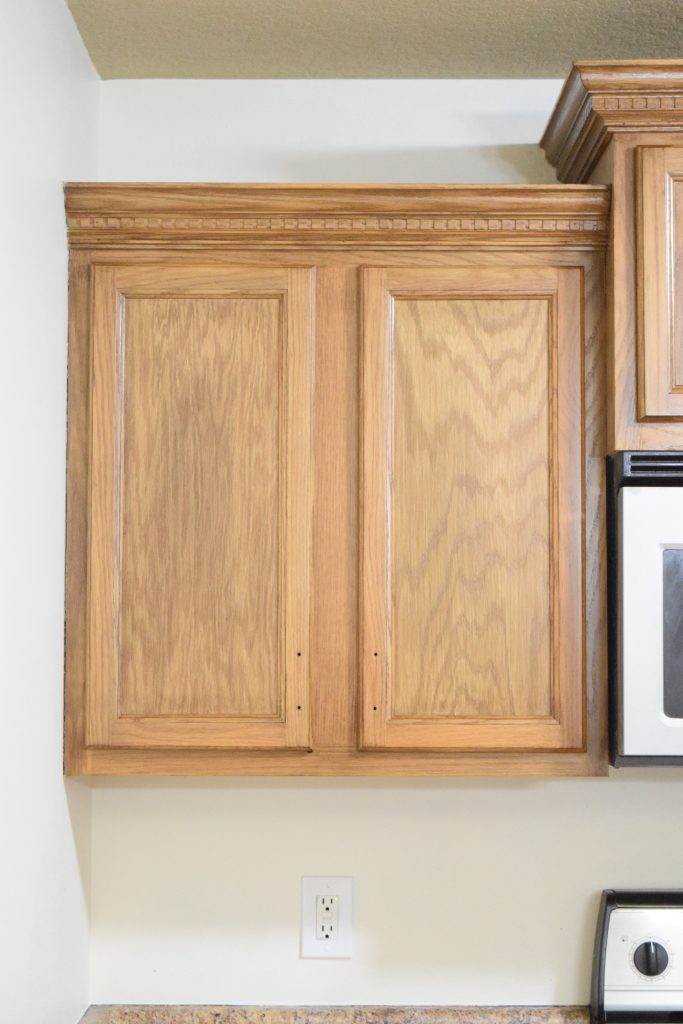
Getting there now!
At this point, I was pretty sure that this stuff was not meant to be applied in multiple coats like this. It started to get thick in the crevices. I could scrape them with my nail and get some of the extra stain and poly out, but the darkness in those areas remained somewhat. We were committed though, so after 6+ hours I sanded with steel wool again, wiped it down, and gave it one more coat.
Here is how my fourth coat looked:
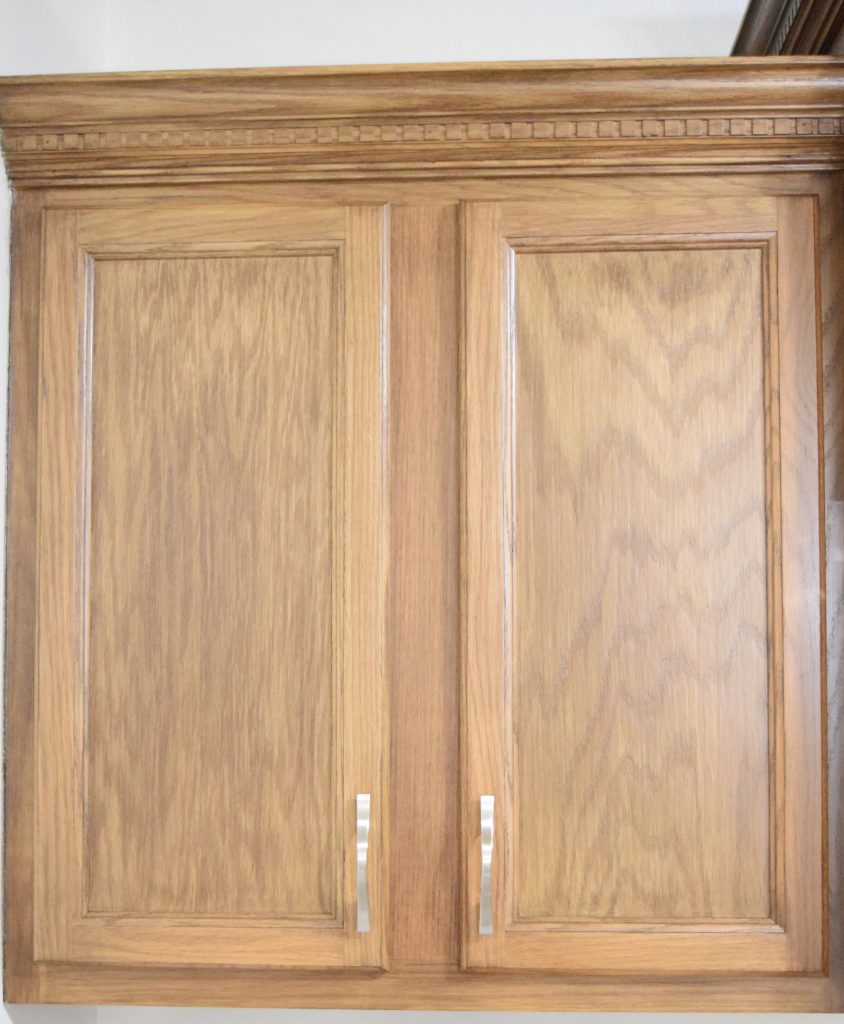
And I'll let you in on a little secret. I use a pretty awesome camera filter on my photos that lightens everything up, making the images look brighter.
This is how dark the cabinets actually are (but see how dingy the photo looks?):
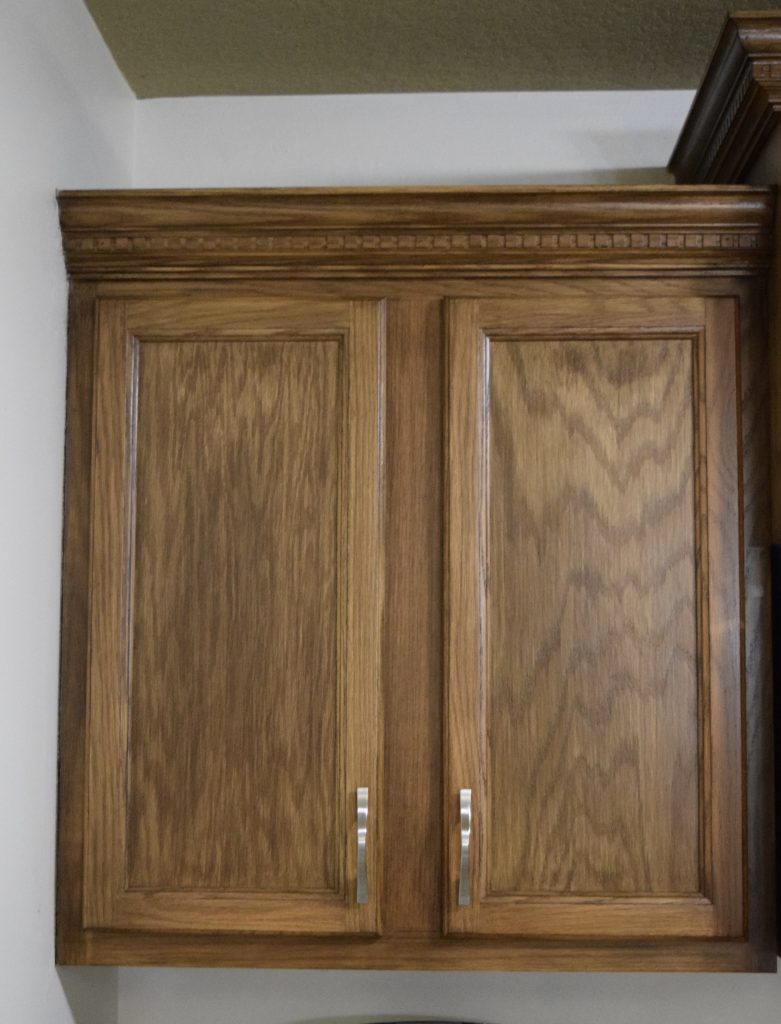
Pretty dark! Not the DARK that I was looking for, but good enough! So I stopped at four coats, because my sanity, and the Minwax itself, would not allow for any more (it was starting to goop in the little crevices – no worries though, I plan to glaze them in the future).
I didn't even finish one whole can of the PolyShades, so the stuff does go pretty far.
So here is my side by side before and after:
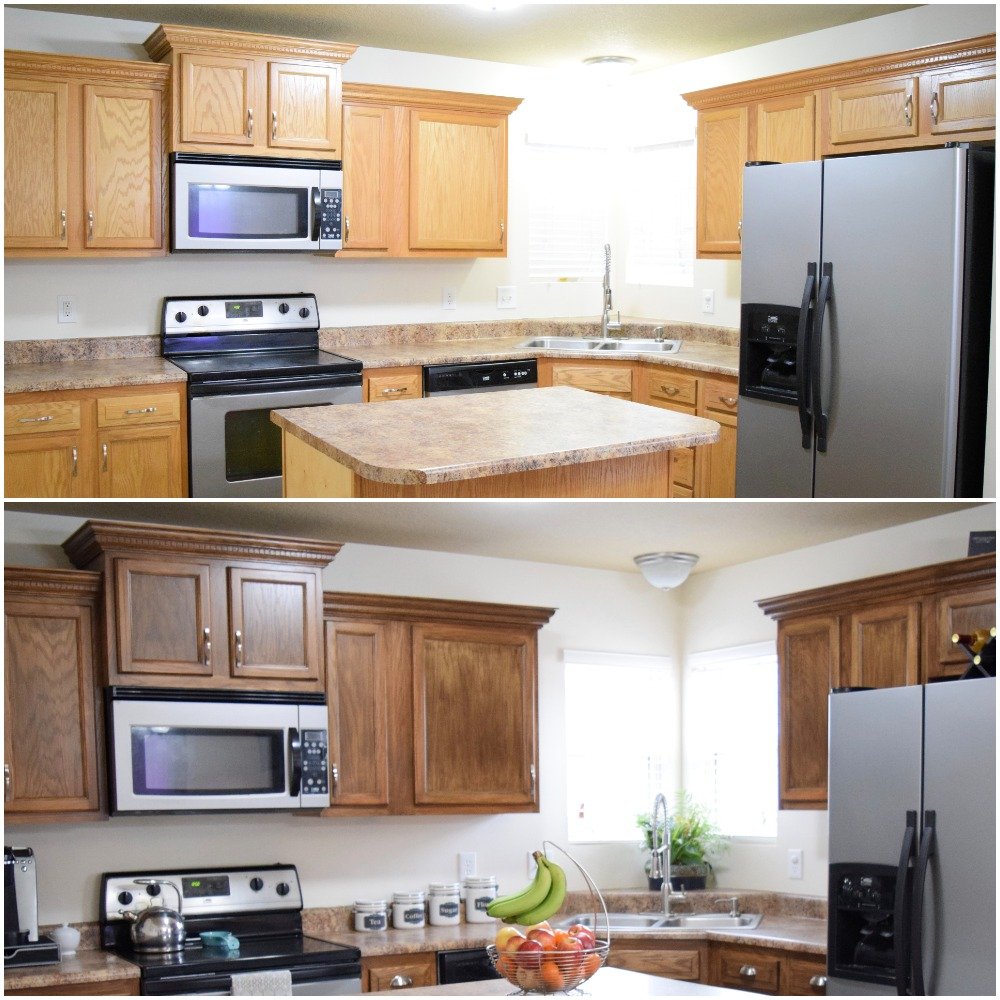
I love how it turned out, and love the darkness of the cabinets. As you can see, I also changed out the handles on the drawers for a cup cabinet pull. It gives a little farmhouse style to the kitchen.
To complete my mini kitchen renovation, I also added trim to and painted the island.
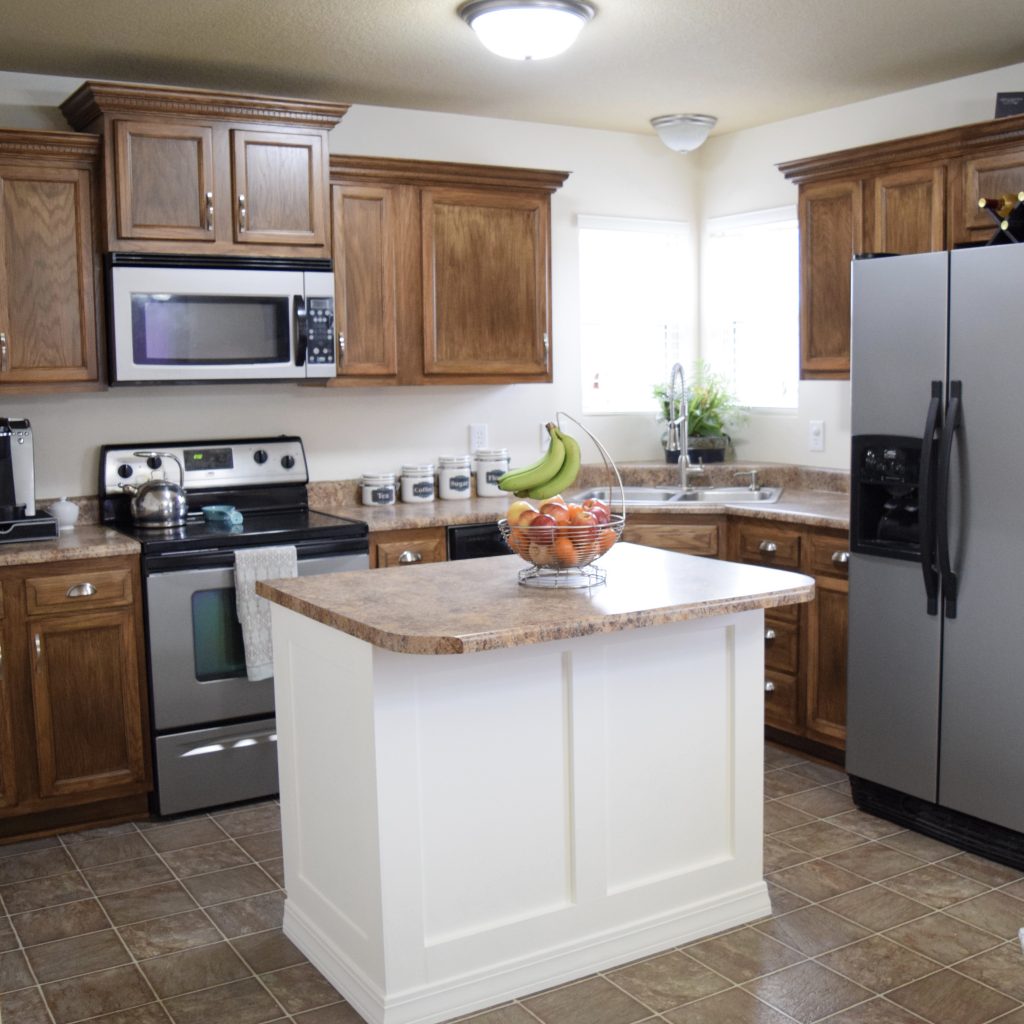
Check out how to add moulding to a kitchen island here.
The best part of this project? It cost me $40, and that includes the new drawer pulls. Total cost for the refinishing? Less than $20.
So all in all, I would call this project a success. The cabinets did not get as dark as I had originally envisioned, but I really like how they look, and I love that it only took 2 days and $40 bucks!
Leave me a comment below and let me me know what you think!
Like this post? Pin it! Or share it on Facebook!
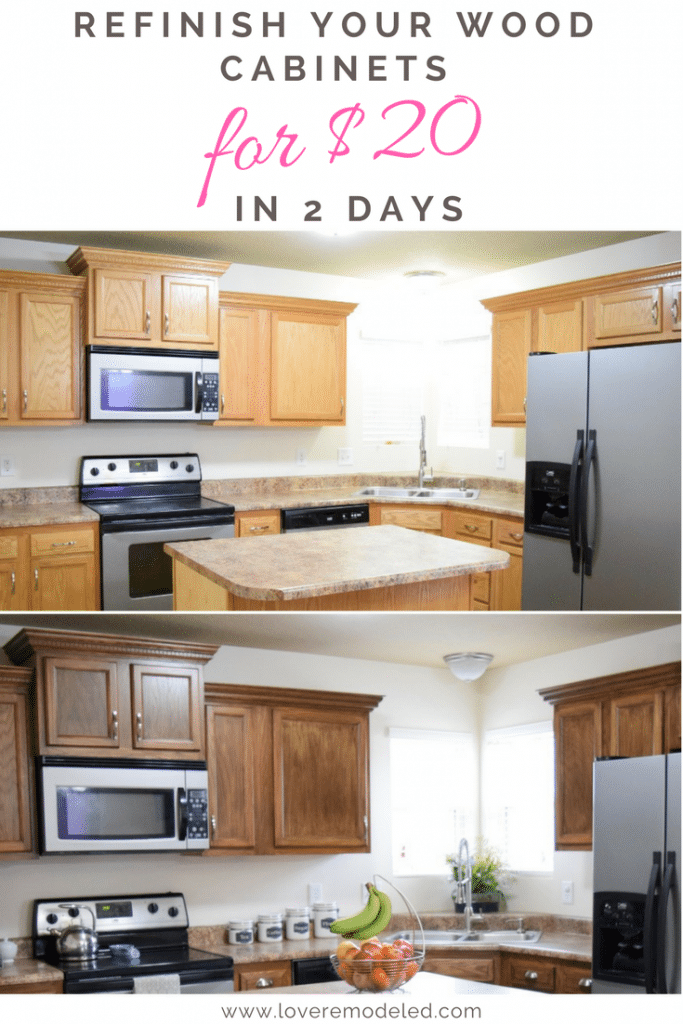
Applying Poly to Old Kitchen Cabinets Thaat Are Spot Stained
Source: https://www.loveremodeled.com/refinish-wood-cabinets-polyshades/